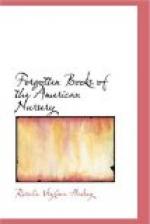[Illustration: The Little Runaway]
And now as we have reached the point in the history of the American story-book when it is popular at least in both English-speaking countries, if not altogether satisfactory to either, what can be said of the value of this juvenile literature of amusement which has developed on the tiny pages of well-worn volumes? If, of all the books written for children by Americans seventy-five years and more ago, only Nathaniel Hawthorne’s “Wonder Book” has survived to the present generation; of all the verse produced, only the simple rhyme, “Mary had a Little Lamb,” and Clement Moore’s “The Night before Christmas” are still quoted, has their history any value to-day?
If we consider that there is nothing more rare in the fiction of any nation than the popular child’s story that endures; nothing more unusual than the successful well-written juvenile tale, we can perhaps find a value not to be reckoned by the survival or literary character of these old-fashioned books, but in their silent testimony to the influence of the progress of social forces at work even upon so small a thing as a child’s toy-book. The successful well-written child’s book has been rare, because it has been too often the object rather than the manner of writing that has been considered of importance; because it has been the aim of all writers either to “improve in goodness” the young reader, as when, two hundred years ago, Cotton Mather penned “Good Lessons” for his infant son to learn at school, or, to quote the editor of “Affection’s Gift” (published a century and a quarter later), it has been for the purpose of “imparting moral precepts and elevated sentiments, of uniting instruction and amusement, through the fascinating mediums of interesting narrative and harmony of numbers.”
The result of both intentions has been a collection of dingy or faded duodecimos containing a series of impressions of what each generation thought good, religiously, morally, and educationally, for little folk. If few of them shed any light upon child nature in those long-ago days, many throw shafts of illumination upon the change and progress in American ideals and thought concerning the welfare of children. As has already been said, the press supplied what the public taste demanded, and if the writers produced for earlier generations of children what may now be considered lumber, the press of more modern date has not progressed so far in this field of literature




